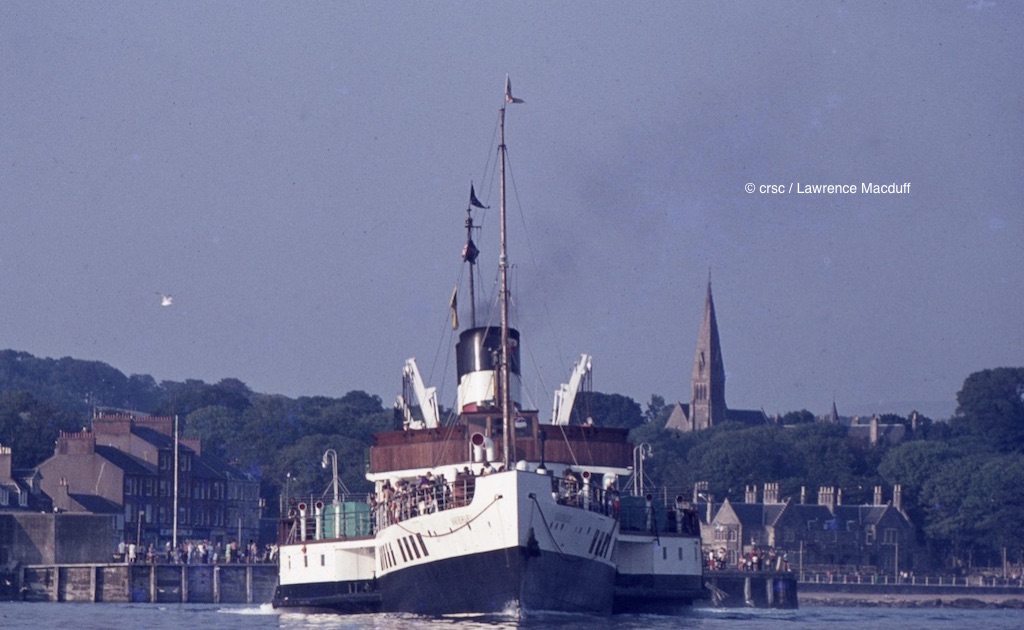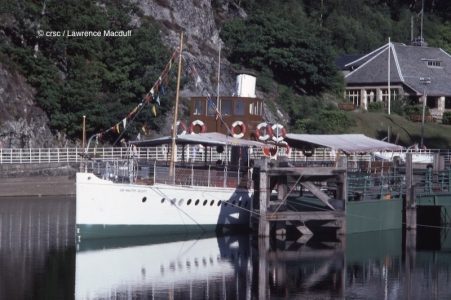
‘How on earth do you hold steady a camera with a 300mm telephoto lens screwed onto the end of it, when sitting in a boat?’: Waverley leaving Millport Bay on 18 August 1976 — remembered as a summer of glorious weather on the west of Scotland
In the latest chapter of his ‘Confessions of a cameraman’, Lawrence Macduff recalls the extremes to which he went to get a good photo — first, capturing Waverley from a rowing boat in Millport Bay, and then clambering through undergrowth to catch an unusual view of Sir Walter Scott from the wooded banks of Loch Katrine.
1976: boating at Cumbrae
In 1975 I was transferred by my employer, Bank of Scotland, to work in its Millport branch. Once I had settled in, I realised it was a stroke of good fortune. I had two summers that were blessed with long spells of sunshine. On the steamer front Waverley had been returned to service thanks to the gargantuan efforts of the Paddle Steamer Preservation Society. CalMac’s Queen Mary also remained in commission for summer cruising, but for a ship and camera buff, this was very much a bonus.

Waverley swings past Lawrence’s rowing boat off Millport in August 1976, when he was working at the bank on Cumbrae
Unlike Queen Mary, Waverley routinely called at Millport, and on one occasion I hired a skiff from big Stewart MacIntyre, the local boat hirer, and went out into the bay specifically to intercept Waverley as she arrived in brilliant sunshine on an evening cruise. If this operation was anything, it was a reminder of ‘the good old days’ when, as a boy in the early 1960s, I had regularly gone out skiff-ing at Dunoon.
There was no big effort required to get out into Millport Bay, and really the only new challenge was to figure out how on earth you could hold steady a camera with a 300mm telephoto lens screwed onto the end of it, even when sitting in a boat in a near flat calm. I did manage a couple of views using it, before my standard lens came into its own as the ship came near.
Then it was a case of watching and gazing, for once from a safe distance, at the majestic sight of this 31-year old ship (which now seems no age as I write these notes 42 years later!) as she glided past me on her way back to Largs, lit by bright evening sunshine from stem to stern.
The sight of Waverley’s advancing tail wake was sufficient prompt to grab the oars and put the skiff’s head into the first of the waves. Then all was calm — just that receding view of her stern profile, the acrid smell of oil fuel fumes, and the sound of steady paddle beats as she gently slipped out of view. What a great way to spend an evening!

‘I got hotter and hotter as I fought my way through long grass and scrub to reach a suitable place to take my pictures of the steamer at Trossachs Pier’: it was worth all the trouble, judging by Lawrence’s photo of Sir Walter Scott on 19 July 1982
1982: Trossachs (flies in the face of common sense)
Once I became mobile as a motorist in 1980, I started to go to various places to take pictures — places which had previously been accessible to me only by public transport. Trossachs was one of these, and the gem here was, of course, Sir Walter Scott, the Denny-built steamer which began her career on the loch in 1900 and had sailed ever since except during wartime.
While pictures of the ship could easily be taken from the pathway at water level along the shore of the loch, one could also climb up amongst the trees to an unofficial viewpoint which in reality was a clearing in the woods. This involved a bit of effort but the view was superb.
The other side of the loch was literally a no go area – there was no visible pathway, but on this visit on a glorious but quite hot July day, I decided that I really would like to get some different views of the little steamer, and so I found a way into the woods behind the gangway shelter that leads onto the pier.
A rocky outcrop beyond the pier diverted me inland a short distance, but the effort soon made me hot and that was when the trouble started.
Out of nowhere, I began to be invaded by bluebottles and I simply could not keep them off my body. Obviously they smelt the sweat a mile off and I got hotter and hotter as I fought my way through long grass and scrub to reach a suitable place to take my pictures of Sir Walter Scott at her pier.
I then had to battle my way back, feeling quite wretched and badly overheated. What one has to go through for the love of steamer photos!
Published on 29 October 2018














